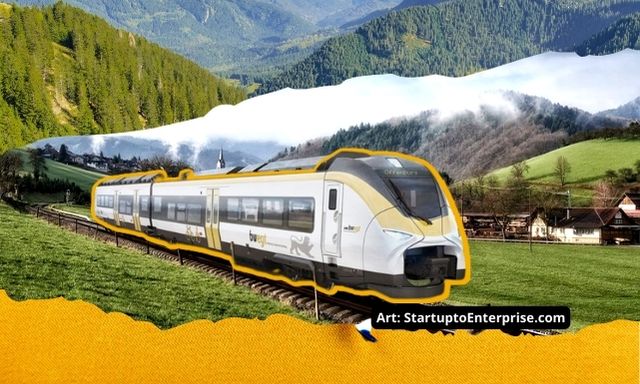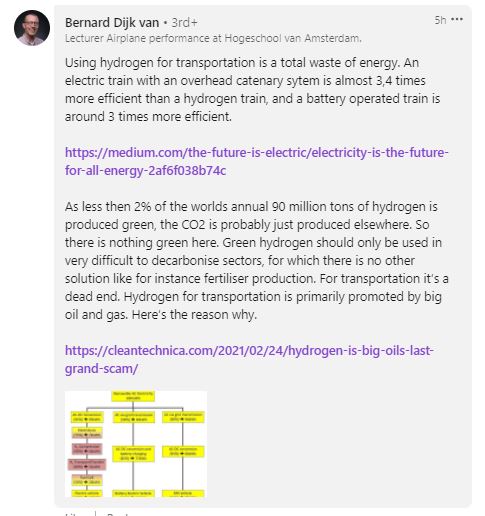

On May 5, 2022, Siemens Mobility introduced the first Mireo Plus H hydrogen train. The event took place at its factory in Krefeld as a part of the H2goesRail project in partnership with Deutsche Bahn (DB).
CEO Region North-East Europe at Siemens Mobility Gerhard Greiter shares a Linkedin post describing his experience. He writes, “A great day at our plant in Krefeld. Together with Deutsche Bahn and the BMVI, we were able to show our Mireo Plus H (hydrogen) to the press. So we now have a magical, sustainable Mireo Trio, in which we can operate on electrified and have the right efficient and sustainable solution for non-electrified networks. DB mentioned their goal to operate without diesel in the future. The infrastructure is also important for this. DB presented an important approach for the future with the mobile hydrogen tank system. The locally emission-free future can now find its way onto all railway lines. A big thanks to all who have worked to bring the Mireo Plus H on the rail.”
The Mireo Plus H hydrogen train rolled out is a two-car configuration with a range of around 800 kilometers. The three-car version can reach up to 1,000 kilometers at a top speed of 160 kilometers per hour. The train is scheduled for a test run in 2023 at Baden-Württemberg. Post-trial, in 2024, the Mireo Plus H will enter into service between Tübingen, Horb and Pforzheim, where it will run for at least 120,000 kilometers. The two partners, Siemens Mobility and Deutsche Bahn (DB), also unveiled a mobile hydrogen storage trailer for fast mobile refueling during the press meet.
CEO Siemens Mobility Michael Peter shares a Linkedin Post expressing his take on the accomplishment. He says, “Happy with a capital H2 as the Mireo Plus H hydrogen train made an impressive debut in Krefeld this morning. Together with Deutsche Bahn in the H2goesRail project, we now have a fast, clean and sustainable solution that will slash CO2 emissions on rail routes that are not electrified. More trials to come, but we are getting very close to seeing this train serving passengers very soon! Great work and innovation by everyone involved.”
According to the partners, fast refueling is key to the future success of hydrogen trains, and the DB and Siemens are working to make the process as fast as that of a regular diesel train. The hydrogen itself will be produced by DB using green electricity.
Board Member at DB, Dr. Daniela Gerd tom Markotten writes, “With this new train and mobile infrastructure system, we are taking another big step towards phasing out diesel and greening our fleet! With green hydrogen, trains run emission-free—only water vapor is emitted, no CO2. The hydrogen is produced by DBEnergie with Ökostrom that comes directly from the overhead contact line.”
Daniela further adds that the Mireo Plus H will start its passenger service in 2024. The hydrogen train will commute between Tübingen and Pforzheim by replacing a multiple-unit diesel-run train to save around 330 tons of CO2 on this route alone.
The overall idea is to replace more and more diesel multiple units with this innovative hydrogen system to achieve climate neutrality by 2040. DB and Siemens Mobility estimate that a hydrogen train running 200,000 kilometers per year can result in annual savings of more than 500 tonnes of CO2.
But here’s the challenge. Lecturer at Airplane Performance at Hogeschool van Amsterdam, Bernard Dijk van has a pulled a tough concern. According to him, hydrogen for transportation is a total waste of energy as an electric train with an overhead catenary system is three to four times more efficient than a hydrogen train, while a battery-operated train is around three times more efficient.

As less than 2% of the world’s annual 90M tonnes of hydrogen is produced green, the CO2 is probably just produced elsewhere. So there is nothing green here. Green hydrogen should only be used in very difficult to decarbonize sectors for which there is no other solution—for example, fertilizer production. For transportation, it’s a dead end. Hydrogen for transportation is primarily promoted by big oil and gas companies.
Dear Reader,
First, thank you for your precious time reading the stories (without paywalls) I publish on Startups to Enterprises covering the EU, China, the US, and India. Second, I request you to contribute financially (any amount) to help me sustain this as an independent digital business news media.
If I receive a request for a sponsored post, I ensure I see merit that is meaningful for erudite and informed readers like you. In the bargain, I lose out on sponsorships wherein I need funds to sustain this effort. Your contribution helps me stay afloat.
Please note that your contribution is treated as revenue generated and not a donation; hence, there are no 80G or other donation certificates. In fact, as I am eligible to pay for the revenue generated, I will pay taxes on the same.
You deserve to know that I abide by journalistic ethics and practices to ensure I tell the stories as is, unbiased. You can follow us on Facebook, Linkedin, and Twitter, bookmark us on Google News, and finally, PayPal us here.
Founding Editor
Linda Ashok

